To effectively target the inner chest, it’s essential to have a basic understanding of the underlying anatomy. The chest muscles, or pectoral muscles, are divided into two main parts:
The pectoralis major comprises the upper head (or clavicular) and the lower head (or sternal). The inner chest is the region between the two pectoralis major muscles.
The best way to build your inner chest is to do exercises that make you move your arms toward your chest’s midline.
Know the best exercises to train the same.
Your Free Calculator To Know Your BODY MASS INDEX
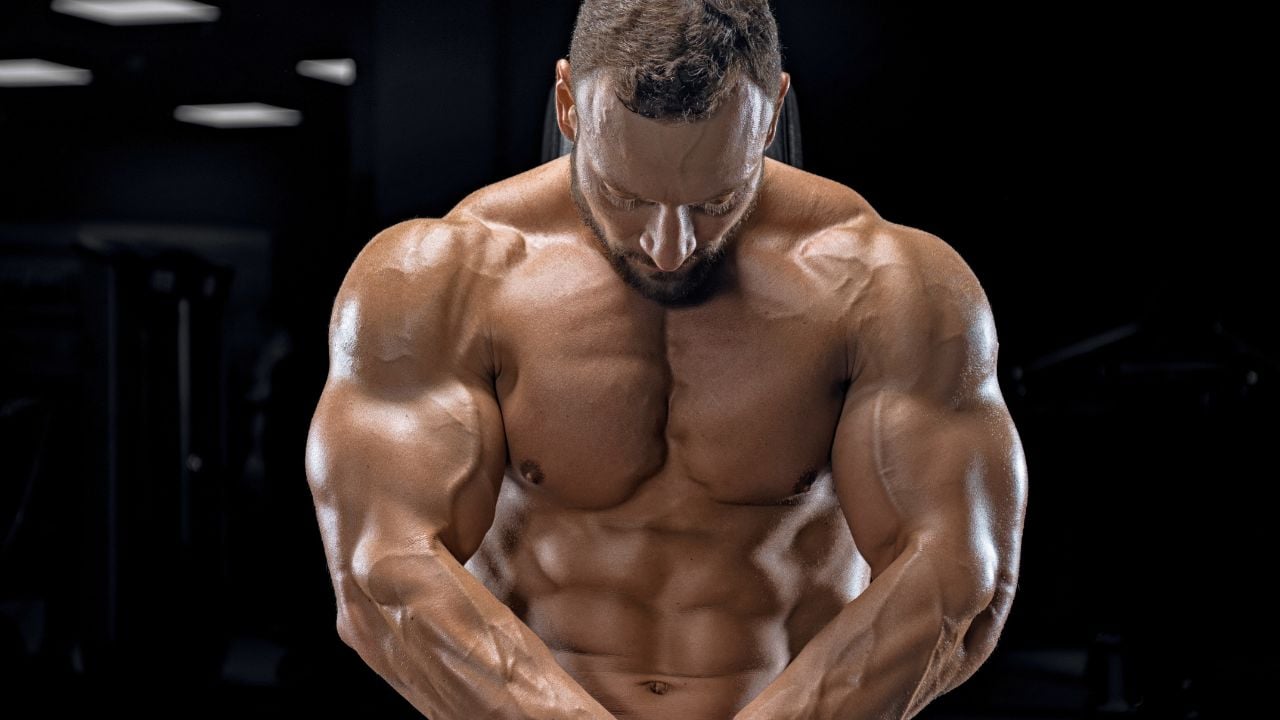
- 10 Best Inner Chest Exercises To Build Mass and Strength
- 1. Cable Crossover
- 2. Dumbbell fly
- 3. Pec Deck Fly
- 4. Landmine Chest Press
- 5. Smith Machine Hex Press
- 7. Single Arm Chest Fly
- 7. Svend Press
- 8. Narrow-Grip Push-Ups
- 9. Dumbbell Squeeze Press
- 10. Dumbbell Pullover
- Beginner Inner Chest Workout Plan
- Takeaway
- References
10 Best Inner Chest Exercises To Build Mass and Strength
Now, let’s explore the best inner chest exercises for strengthening your chest and improving posture using various types of fitness equipment and some bodyweight workouts that you can do at home.
Here is a list of the 10 best exercises for strengthening the center chest and achieving a strong, defined chest.
1. Cable Crossover
The Cable Crossover is a cornerstone for inner chest development due to the specific action it facilitates: Horizontal Adduction of the Shoulder Joint (Means moving the hand toward the centre).
This line of pull is optimal for activating the inner region of the chest, as it forces you to contract and “squeeze” the pecs at the peak.
I often cue my clients to imagine hugging a tree—this helps them keep the arms in the proper arc rather than turning it into a press.
Best Variations Of Cable Crossover
- High Cable Crossover: Set the cables to a high position to target the lower chest muscles
- Low Cable Crossover: Set the cables low to target the upper chest muscles.
- Single-Arm Cable Crossover: Perform the exercise one arm at a time to increase stability and engage the core muscles.
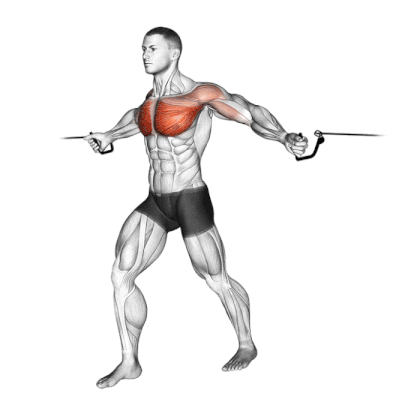
How To Do
- Set pulleys to the desired height (High, Mid and Low – though all hit the inner pecs significantly).
- Choose a manageable weight that allows for the full range of motion and a strong squeeze.
- Grab handles, step forward (split stance or feet together for stability), lean slightly forward from the hips (maintain a neutral spine), chest up, shoulders retracted.
- With a slight, fixed bend in the elbows (similar to hugging a barrel), bring the handles in an arcing motion towards the midline of the body.
- Focus intensely on squeezing the inner portion of the chest as if trying to touch your sternum with your muscle.
- Slowly allow the arms to return to the starting position, feeling a stretch across the chest.
- Go back just until you feel a good stretch, avoiding excessive shoulder extension, which can put stress on the joint.
2. Dumbbell fly
The dumbbell fly is a classic hypertrophy movement that I regularly program to isolate and stretch the chest muscles, especially to improve inner chest definition
During the fly, focus on horizontal adduction, bringing the arms from a wide position toward the midline of the body. This directly activates the sternal (inner) fibers of the chest.
Try other variations of chest fly to train the inner pec muscles:
- Incline dumbbell fly: To target the upper and inner portions, perform the fly on a 30–45° incline bench.
- Incline cable fly: Set pulleys to low position, use a slight incline angle.
- Decline Dumbbell Fly: Focuses on lower and inner chest. Performed on a decline bench (15–30°).
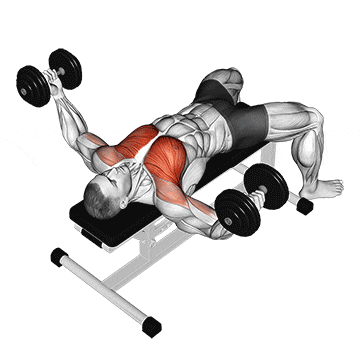
How To Do
- Select a bench (Flat, Incline at 15-30 degrees, or Decline).
- Sit on the bench with dumbbells on your knees, then lie back while simultaneously kicking the dumbbells up to the starting position above your chest.
- Ensure back is slightly arched (natural lordosis), shoulders are pulled down and back (scapular retraction/depression) and remain stable, and feet are firmly on the floor for stability.
- Slowly lower the dumbbells out to the sides in an arcing motion.
- Control the descent. Do not let gravity pull the weights down quickly.
- Reverse the motion, bringing the dumbbells back up in the same arcing path.
- Bring the dumbbells together above the chest. Avoid letting them clank forcefully; maintain control.
3. Pec Deck Fly
The pec deck fly is an isolation exercise primarily targeting the chest muscles, including the inner chest. It is popular in gyms and fitness centers because it isolates these muscles.
This means that the exercise only works the chest muscles without actively working the triceps or shoulders.
This exercise provides a smooth and controlled movement, resulting in a more focused and intense workout. It is used in strength training and bodybuilding routines to build bigger and stronger chests.
My main focus when doing this exercise is creating a mind-muscle connection to maximise the output.
EMG data shows that machine fly and bench press both activate the pectoralis major muscle similarly.
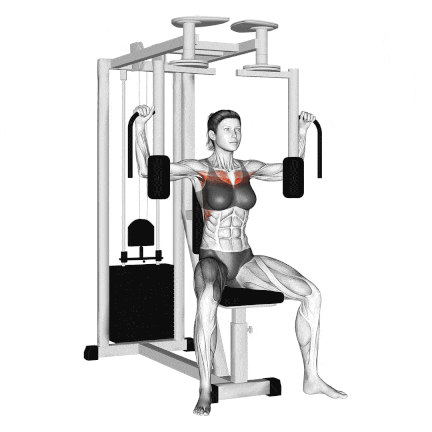
How To Do
- Adjust the seat so that your feet are flat on the floor.
- Ensure that the handles are at chest level or slightly below.
- Grab the vertical handles with elbows slightly bent.
- Keep your chest lifted, shoulders down and back, and core engaged.
- Exhale as you slowly bring the handles together in front of your chest.
- Once the handles are together, pause briefly at the fully contracted position. Squeeze your chest muscles and feel the tension in the target area.
- Inhale and gradually release the handles, allowing your arms to return to the initial position.
4. Landmine Chest Press
If you’re looking for a way to get more creative with your inner chest workout, why not try the landmine chest press?
The landmine press is not popular, yet it provides many benefits, like progressive overload.
Unlike a standard horizontal press (like a bench press), where gravity provides resistance straight down, the landmine setup creates an upward and inward arc as you press.
This path closely resembles the horizontal adduction component present in flyes, but under a pressing load. The resistance naturally pushes the bar towards the midline of your body as you extend.
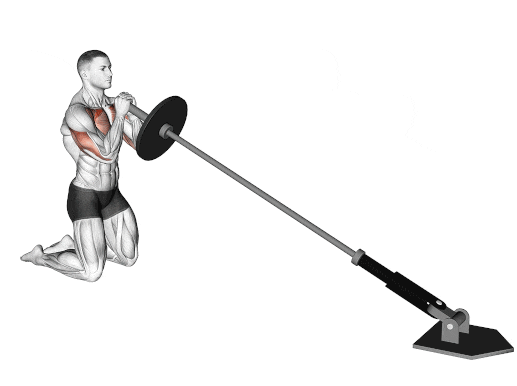
How To Do
- Secure one end of a barbell in a landmine attachment or the corner of a room (ensure padding if using a corner).
- Load the other end of the bar with appropriate weight.
- Assume a half-kneeling position with the knee under your hip, toes tucked, and rib cage down.
- Interlaced hands at the end of the bar, one hand slightly over the other.
- The bar end is held near the sternum/upper chest, and the elbows are tucked slightly (approx 45 degrees relative to the body, not flared straight out). Torso relatively upright (slight forward lean is okay, but avoid excessive leaning back). Core braced.
- Exhale and press the bar upward and forward along its natural arc. Actively squeeze the inner chest, as if trying to bring your pecs together in the middle.
- Inhale and slowly control the bar back down along the same arc to the starting position near the chest.
5. Smith Machine Hex Press
The Smith Machine Hex Press is one of my go-to chest isolation movements when I want to target the inner chest specifically.
It’s a powerful variation that combines the benefits of a press and a squeeze with added stability from the Smith machine.
However, it is challenging to organize and requires much attention and detail to perform this workout.
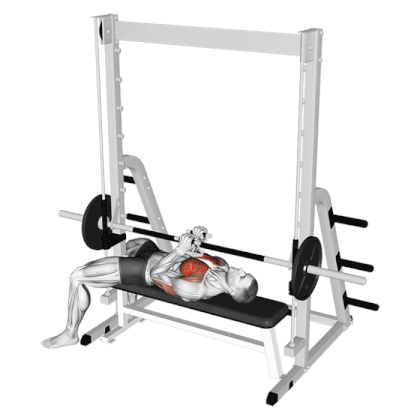
How To Do
- Set up a bench under the Smith Machine bar. Position it so the bar descends to roughly mid-chest or slightly lower.
- Lie back on the bench with your eyes directly under the bar or slightly forward.
- Reach up and grasp the bar with an extremely close grip, hands touching or nearly touching or a V-grip attachment.
- Unrack the bar. Ensure shoulders are stable, pulled down, and back. Feet firmly on the floor.
- Inhale and slowly lower the bar down towards your chest. The bar path is fixed.
- Keep elbows relatively tucked towards the sides (closer than a standard bench press due to the grip).
- Lower until the bar is near your chest.
- Exhale and press the bar straight back up along the Smith Machine path. Repeat 10–12 reps.
Know More: 14 Best Cable Chest Exercises
7. Single Arm Chest Fly
The Single-Arm Chest Fly is an advanced unilateral variation that targets the inner chest and challenges core stability and muscle control.
The cable allows for a deep stretch at the starting position (shoulder abducted) and a complete cross-body contraction.
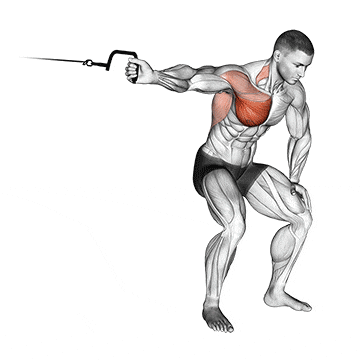
How To Do
- Set the cable pulley to the desired height (Mid-height is most common, and high and low are all effective for the inner portion due to the cross-body movement).
- Stand sideways to the cable tower. Grab the handle with the arm furthest from the tower.
- Use a staggered or split stance (foot closest to the tower forward) for better balance and to brace against rotation. Feet hip-width or slightly wider.
- Stand tall, slightly forward, and lean from the hips (optional, but can slightly increase pec stretch/engagement). Maintain a neutral spine.
- Exhale and bring the hand in an arcing motion across the front of your body, towards the opposite side.
- Actively contract the inner chest as you bring the hand past the midline.
- Inhale and slowly control the working arm back to the starting position, resisting the pull of the cable.
Read More: Cable Fly: Muscle Worked, Alternate, Variations
7. Svend Press
The Svend Press is a unique isolation exercise designed to create high tension specifically in the inner chest fibers through a combination of isometric squeezing and a pressing motion.
It gives the constant, forceful inward squeeze applied to the weight (plate or dumbbells). This challenges the pectoral fibers responsible for horizontal adduction (bringing the arms across the body towards the midline).
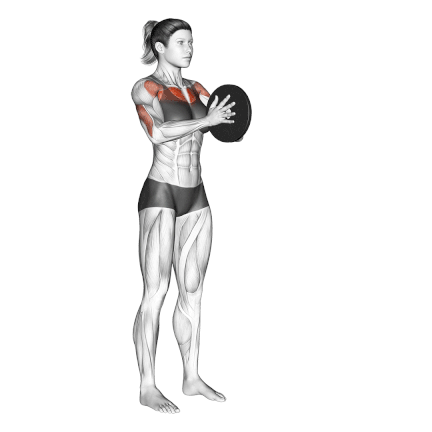
How To Do
- Pick a weight plate that you can comfortably hold and squeeze forcefully for your target rep range (typically 10-20+
- It’s better to start too light and add weight only when the squeeze feels maxed out.
- Stand tall with feet shoulder-width apart, knees slightly bent, and core braced. Kneeling is also an option for more stability.
- Hold the weight plate vertically between your palms, pressing your palms together against it firmly.
- Bring the weight up to touch your chest (sternum level). Keep elbows relatively tucked (not flared out). Start squeezing the plate/dumbbells as hard as you can.
- Exhale and press the weight(s) straight forward away from your chest.
- As you press, continue and intensify the forceful inward squeeze on the weight. Imagine you are trying to crush the plate
- Inhale and slowly control the weight(s) back towards your chest.
8. Narrow-Grip Push-Ups
Narrow grip push-ups are the best bodyweight workout for building your entire upper body, including shoulders, chest, and triceps. It’s one of the best inner chest exercises you can do at home.
This is evidenced by a study that found greater electromyography (EMG) activity in the triceps brachii and inner chest when doing close push-ups compared to when executing regular push-ups.
It can be challenging, so starting with a modified version (knee push-ups) is important if needed.
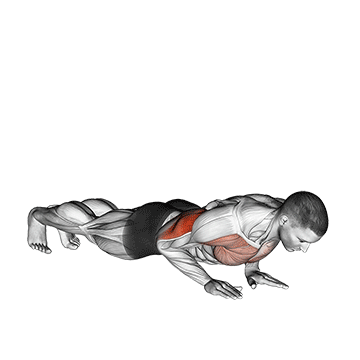
How To Do
- Begin in a plank position with your hands directly under your shoulders and your feet hip-width apart.
- Move your hands closer together so that they are directly under your chest, with your fingers pointing forward.
- Lower your body towards the ground, keeping your elbows close to your sides.
- Pause at the bottom of the movement and then push back up to the starting position.
Read More: Best Push-Ups For Inner Chest To Build Size And Strength
9. Dumbbell Squeeze Press
The dumbbell squeeze press movement combines horizontal pressing and isometric adduction, which gives the inner pecs continuous load.
This constant isometric tension activates the sternal (inner) head of the pectoralis major by forcing the chest to contract inward during the push.
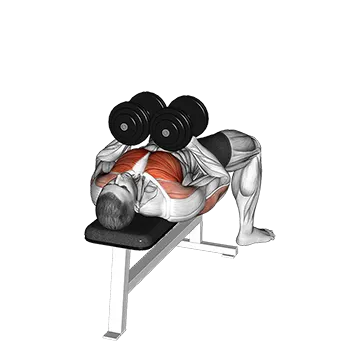
How To Do
- Select a pair of moderate-weight dumbbells.
- Lie back on a flat bench (or incline for upper-inner, decline for lower-inner). Keep your feet firmly on the floor for stability.
- Position the dumbbells together, palms facing each other (neutral grip). The ends of the dumbbells should touch throughout the set.
- Dumbbells held together directly over your chest, arms extended but not locked out. Maintain this intense inward squeeze throughout the entire set.
- Inhale and slowly lower the dumbbells straight down towards your sternum or upper chest.
- Keep your elbows relatively tucked towards your sides (around 45 degrees or less from your torso).
- Exhale and press the dumbbells straight back up to the starting position above your chest.
10. Dumbbell Pullover
The classic dumbbell pullover is a widely used resistance exercise that primarily strengthens the muscles in the chest and back.
It also engages the large wing-shaped muscles in the back (latissimus dorsi), the core muscles, and the triceps.
It involves lying down on a bench and moving a dumbbell over your head while maintaining a slight bend in your elbows. They are an excellent addition to your upper body strength routine.
There are variations of pullover that help to grow the inner chest.
- Barbell pullover
- Cable Pullover
- Incline pullover
- Decline pullover
- Swiss ball dumbbell pullover
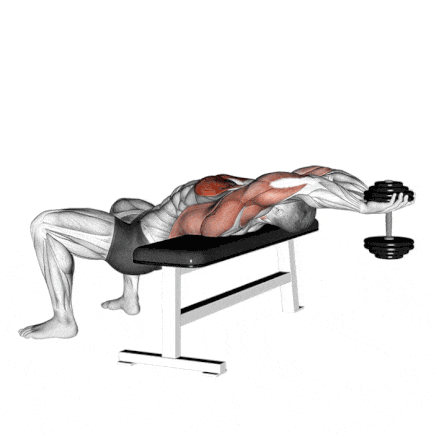
How To Do
- Lie across a bench on your shoulders so that your head hangs.
- Grasp a dumbbell with both hands and get it straight over your chest.
- Lower the dumbbell in an arc slowly, getting a good stretch in your rib cage.
- Lower the dumbbell as far as possible and then raise it back to the starting position.
Beginner Inner Chest Workout Plan
The following inner-chest workout is highly effective and would show results if done with proper technique and sequence.
You can do a beginner chest workout at home if you have dumbbells. Otherwise, you can perform these exercises at the gym.
| Exercise | Sets | Reps |
|---|---|---|
| Close Grip Push-Ups | 4 | 10-15 |
| Dumbbell Squeeze Press | 3-4 | 10-12 |
| Dumbbell Fly | 4 | 10-12 |
The best rep ranges and loads to work with.
- For muscle endurance: Aim for 15-20+ reps with moderate resistance.
- For muscle strength: 6-10 reps, with more resistance.
- For muscle hypertrophy (increased muscle size): Aim for 3-4 sets of 8-12 reps, with a moderate to heavy amount of resistance.
Takeaway
This best Inner chest Exercise and Workout plan is highly recommended for anyone interested in building body strength and gaining muscle.
It is easy to do and requires no more scientific details. If done consistently, the results will speak for themselves.
Thanks for reading; enjoy a workout
References
- Hrysomallis C. Effectiveness of strengthening and stretching exercises for the postural correction of abducted scapulae: a review. The Journal of Strength and Conditioning Research. 2010;24(2):567-574.
- Schoenfeld, B. J., Ogborn, D., & Krieger, J. W. (2017). Dose-response relationship between weekly resistance training volume and increases in muscle mass: A systematic review and meta-analysis. Journal of sports sciences, 35(11), 1073–1082.
- The Effect of Weekly Set Volume on Strength Gain: A Meta-Analysis.
- Comparative Study Eur J Sport Sci. 2016;16(3):309-16. Epub 2015 Mar 23. Influence of bench angle on upper extremity muscular activation during bench press exercise.

Manish is a NASM-certified fitness and nutrition coach with over 10 years of experience in weight lifting and fat loss fitness coaching. He specializes in gym-based training and has a lot of knowledge about exercise, lifting technique, biomechanics, and more.
Through “Fit Life Regime,” he generously shares the insights he’s gained over a decade in the field. His goal is to equip others with the knowledge to start their own fitness journey.

